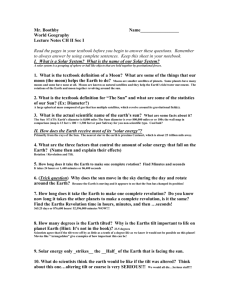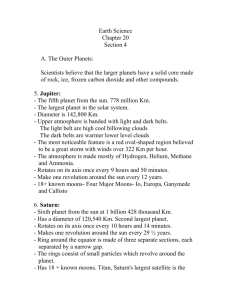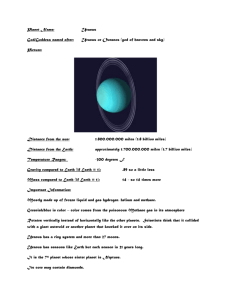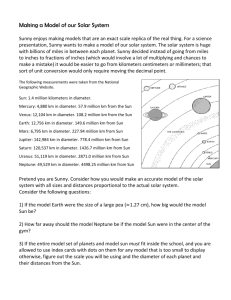solar system
advertisement
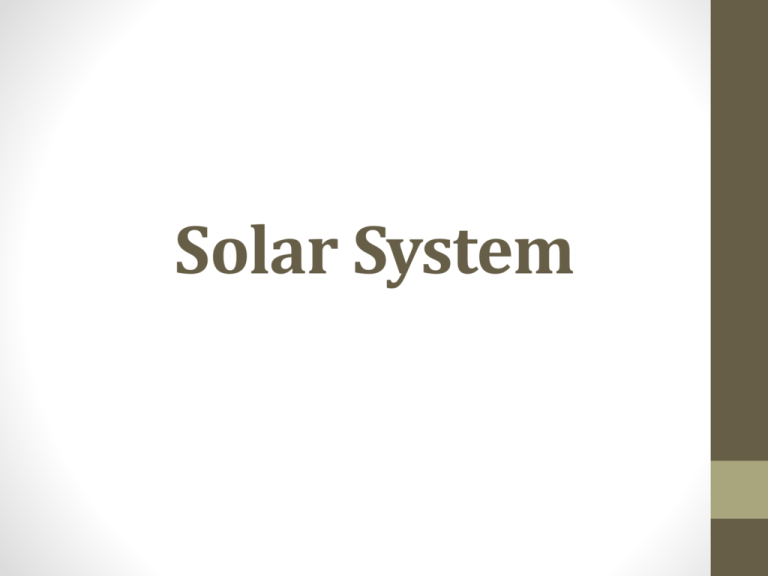
Solar System MERCURY • By Connor and Aly Physical Description, Distance from the Sun • Surface: -170°C to 450°C, very thin atmosphere, vast craters, irregular, cliffs and mountains, thin crust (300-400 miles) • Inner Core: very large, dense, metallic core • Distance: 6.2837e7 km or 0.38 AU Solar Magnitude, Orbital Period, Rotational Period • Magnitude: +5.7 to -2.3 • Orbit: 88 Earth days, very elliptical • Rotation: 59 Earth days Diameter, Mass, Density • Diameter: 4880 km 0.4 Earth’s diameter • Mass: 328.5e21 kg or 0.055 Earth’s mass • Density: 5.43 g/cm^3 Satellites, Interesting Facts, Composition • Satellites: No known moons • Facts: Mariner 10 was the first man-made craft to land on mercury • Atmospheric Composition: Hydrogen, Helium, Sodium, Magnesium and more Jupitar • Physical Description - Colourful atmospheric features - diameter = 142,984km • Distance from Sun - 5.20 AU • Orbital Period -12 years • Rational Period - 10 hours • Equatorial Diameter -142,984 km • Mass - 1.898E27 kg (317.8 Earth mass) • Density 1.33 g/cm³ Satellites Facts • Jupiter has 63 moons • every 100 pounds on Earth = 264 pounds on Jupiter Venus By: Marin Schindell PHYSICAL DESCRIPTION • 487 trillion km in density • Big and bright from the gases • Sister planet to earth • Very hot (462 C) • Radius: 6,052 • Surface area: 460,234,317 km² DISTANCE FROM THE SUN • Second planet from the sun • 108,200,000 km From the sun • Clockwise rotation • Length of day: 116d 18h 0m APPARENT SOLAR MAGNITUDE • Apparent solar magnitude: -4.4 IMAGES • • ---This image is from: http://en.wikipedia.org/wiki/Venus • • ---This image is from: http://www.mallorcaweb.net/masm/Planeta1.htm --This image is from: http://www.astronoo.com/pt/artigos/oxigenio.html URANUS BY: Prarthana Bhat and Michael Sotnick URANUS • Discovered in 1781 • Gas planet • Has bands of clouds occasionally fainting & appearing • Nearly same size of Neptune http://solarsystem.nasa.gov/planets/profile.cfm?Object=Uranus URANUS • Density – 1.27 g/cm3 • Mass – 86.81 x 1024 kg (Earth=14.54) • Atmosphere • 83% Hydrogen • 15% Helium • 2% Methane (Gives blue tint) http://www.space.com/45-uranus-seventh-planet-in-earths-solarsystem-was-first-discovered-planet.html URANUS • Rotational Period – 84.02 Earth Years • Solar Magnitude: +5.9m • 2.88 Billion Km from sun (19.2 AU) http://img0.mxstatic.com/wallpapers/4b43f69223f0a9f6d91bd57 cd62898f6_large.jpeg • 27 known moons URANUS • Discovered by William Henschel on March 31, 1781. • First Planet discovered by Telescope • Surface Temperature= -197oC • Gravity: only 91% of the gravity on Earth http://starcityastrology.wordpress.com Pluto Small Icy/Cold Rocky 157x = 1,400 km 1x Density – 2.03 ± .06 g/cm³ Mass – 1.309 x 10 24 Distance – 5.9 billion km Satellites (moons) Orbital Period – 247.68 years Rotational period – 6.387 days Interesting Facts • Discovered by Clyde W. Tombaugh • Surface temp. – 44 k (-229.15°C) • Composition – CO₂, CH₄, N, H₂O Neptune Orbital period - 165 earth years Rotational period (equatorial) of 16 hours and 6 minutes Equatorial diameter – 49,528 km Mass – 1.0241x1026 kg Density – 1.64 g/cm3 4,503,000,000 km from the sun Solar magnitude – 7.8 13 natural satellites/moons 4th largest planet Smallest gas giant Diameter is 3.9x that of earth Voyager 2 visited in 1989 MARS ✤ fourth planet from sun ✤ second smallest ✤ high concentrations of iron oxide (rust) ✤ thin atmosphere ✤ 639E21 kg (which is 0.107 Earths mass) ✤ 227,900,000 km away from the sun ✤ 3.93 g/cm(3) ✤ 687 day orbital cycle ✤ 24:37:36 rotational period ✤ diameter of 6,779 km (53% of earths) ✤ Phobes and Deimos (captured asteroids) ✤ Phobes moves closer every year ✤ 30+ to -191 F The Sun, solar system Assignment Also known as a yellow dwarf star Looks: A bright hot yellowy orange sphere Some stats The sun’s diameter is 1,391,000 km. Mass:1.9891*1e30 Surface temperature is 5,778 k. The core temperature is 15, 600, 000 k. Interesting facts planets revolve around the sun. looks: bright hot yellow sphere. 25 million years to revolve around the galaxy Gases that make the sun 74% hydrogen, 24% helium other 2% is heavier elements. By: Cameron and Nicholas References http://science.nationalgeographic.com/science/photos/sungallery/ http://www.sciencekids.co.nz/sciencefacts/space/sun . http://palmtreeofdeborah.blogspot.ca/2012/04/what-is-really-goinghtml on-with-2012.html gojulesgo.com:2011:05:16:this-ones-a-realgas:.webloc blogs.telegraph.co.uk:.webloc babblefrommyhead.wordpress.com:.webloc


